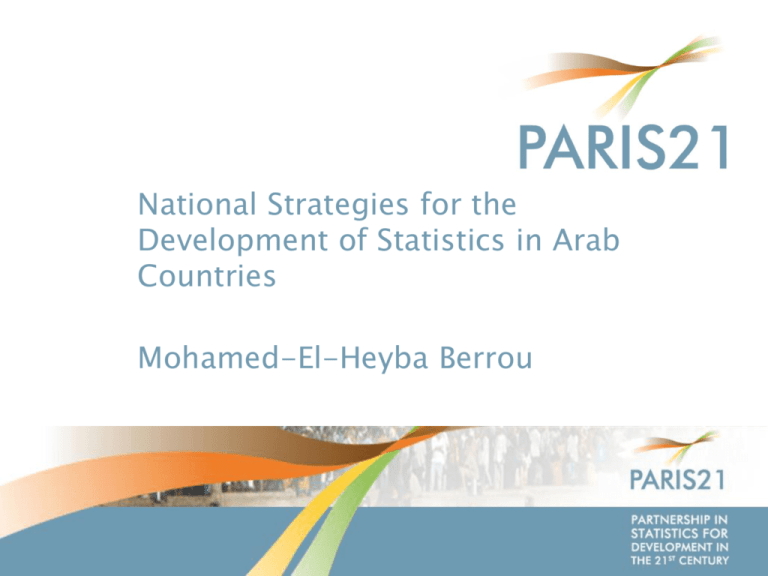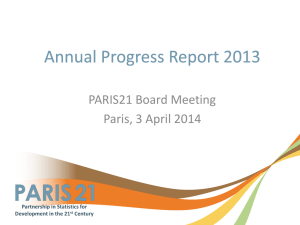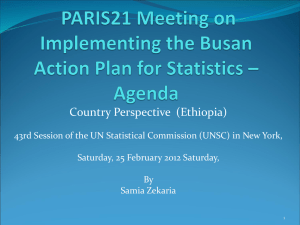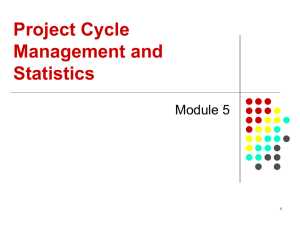NSDS
advertisement

National Strategies for the Development of Statistics in Arab Countries Mohamed-El-Heyba Berrou PARTNERSHIP IN STATISTICS FOR DEVELOPMENT IN THE 21ST CENTURY Who Are PARIS21? International partnership of users and producers of statistics for development from developing & developed countries and multilaterals Ministers of Finance, Sector Ministers, etc. Central Stat. Office, Sector Units, Central Banks, etc. Development Agencies, WB, IMF, RDB, etc. NSO Managers, UN Specialised Agencies; Stat. units in intl orgs DEVELOPING COUNTRIES PRODUCERS OECD COUNTRIES & MULTILATERALS USERS Goal to develop a culture of Management for Development Results = Better Development Outcomes Promoting a focus on results Encouraging the demand for, and use of, statistics across society An increased capacity to produce and analyse statistics A better dialogue between the producers and users of statistics Promoting an efficient use of national and international resources in a national statistical system that is focussed on the user’s needs and embedded within national development policies. PARIS21 promote and facilitate 1. Coordination among partners at all levels 2. Advocacy for national statistics 3. NSDS National Strategies for the Development of Statistics 4. Knowledge for Statistics SDS Focussing on the next 4 or 5 years Brings together decision makers to have a coherent conversation about statistical priorities NSDS Facilitates the production of better statistics and better statistical analysis, Identifies – and responds to – the priorities of national decision makers (including those from civil society and elsewhere) and international stakeholders. NSDS Today, 74 of the 79 countries eligible for Internal Development Assistance have adopted an NSDS process, as have 35 of the 39 Lower Middle Income Countries. NSDS in the Arab Region There are at least 9 countries with an NSDS or some strategy for statistics We are working with countries in the region to improve this situation The Qatar Example Qatar’s NSDS Launched in 2007 To strengthen statistical capacity across entire Qatari NSS Builds on previous work development. NSDS vision is to achieve a coherent, integrated system of national statistics that responds to national and international user needs for high-quality statistical information to support evidence-based decision making and to monitor social and economic Qatar’s NSDS Document Includes • • • • • • • Roadmap for an NSDS Inputs for a national strategy An assessment of Qatari statistics Foundations for an NSDS Strategic Goals and Subgoals Enabling Sub-strategies Implementation plan What is an NSDS? • A nationally-owned, participatory dynamic process integrated into the development policy process covering the whole National Statistical System (NSS) • Aiming at developing statistical capacity to meet the demand for data necessary to conduct national development policies and respond to international requirements • Providing a vision for where NSS should be in 5-10 years time • Coherence framework and prioritised action plan for capacity building and for funding decisions • Framework for coordination arrangements: across NSS and between donors SDS What makes for good statistical capacity development? • Strategic planning crucial to statistical development – – – – – – • Addresses data limitations across whole national statistical system Prioritises data needs Harmonises all national / international programmes Integrates stats within policy / budgetary processes But it has to be a rigorous process! And it has to take into account what already exists! Strategic planning (NSDS) emphasised in international fora: – Marrakech, Hanoi, Accra roundtables, Statistics for Results Facility – Dakar Declaration on the Development of Statistics NSDS as a country coherence framework: int’l programmes ICP DHS MICS NSDS as a country coherence framework: int’l programmes ICP ICP DHS DHS MICS MICS NSDS as a country coherence framework: national system Edu. Agri. Health Labour NSDS as a country coherence framework: national system Agri . Healt h Edu . Labour NSDS Coming Soon… The NSDS Quality Assessment Framework • Helps countries to assess their NSDS and see how it compares to others around the world • Based on a self-assessed questionnaire • A summary index, with three component indices – NSDS Environment, – NSDS Process – NSDS Content Mainstreaming Sectors: Possible Obstacles • Legal environment: statistical law and co-ordination structure missing • First generation of NSDSs has been NSO-centric: easier to design • In some sectors, the statistical function does not exist • Lack of knowledge of policies by statisticians • Lack of human resources and inadequate funding • Influence of donors and international institutions on their sector without interest in co-ordination • Sometimes absence of ownership of the process Mainstreaming Sectors Bottom-up approach: a few countries • Advocacy workshop at Government level • Statistical committees for each sector • Identification of main statistical products • In line with national/ international policies • Identification of users • Reporting mechanism for each sector Health • Sectoral strategies of 3 years • Inter-agency committee on statistics • Compilation and design of NSDS Agriculture Education Finances NSDS Others Mainstreaming Sectors Top-down approach: majority of countries • Global NSDS • With Sub-committees on sectors • Overall NSDS Agriculture Others Health NSDS • Sub-strategies for sectors • More detailed for sectors if necessary Finances Education Mainstreaming Sectors How to ensure a better integration of sectors? • Importance of coordination mechanisms (National Councils) • Line ministries and other data producers to be involved in the process from the beginning • Advocacy is a key element • Donors’ responsibility in terms of alignment NSDS: Four main principles 1. The NSDS should be integrated into national development policy processes and context, taking account of regional and international commitments 2. The NSDS should be developed in an inclusive way, incorporating resultsbased management principles and meet quality standards 3. The NSDS should be comprehensive and coherent and provide the basis for the sustainable development of statistics with quality “fit for purpose”. 4. The NSDS should show where the statistical system is now, how it needs to be developed and how to accomplish this. NSDS: Six phases 1. Commitment 2. Roadmap 3. Assessment (Where we are now?) 4. Vision, mission (Where do we want to be?) 5. Strategy and plan of actions (How do we get there?) 6. Implementation, monitoring and evaluation > Phase of Assessment Where we are now? • Reviewing the legal and institutional framework, linkages, and coordination arrangements • Linkages and coordination arrangements • Assessing organisational factors using e.g. SWOT • Assessing statistical products using e.g. DQAF, GDDS > Vision, mission Where do we want to be? • Agree a mission and vision statement • Agree on desired results • Set priorities to deliver the vision and results > Strategy, plans of actions How do we get there? • Translate strategies into a detailed implementation or action plan, including: What is to be done, by whom and when (key actions) Actions to address each strategic issue and to reach goals Results and outputs to be achieved Detailed costs, overall budget and a financing plan Reporting, monitoring and evaluation arrangements TO RECAP: an NSDS can help by •Addressing data limitations •Prioritising the use of resources •Looking across whole NSS •Integrating statistics within policy processes •Coordinating donor support •Providing a robust framework and action plan for statistical capacity building •Acting as a catalyst for change to build confidence and break the vicious cycle TO RECAP: NSDS Continuity & Flexibility • Strategic management is a continuous process • Design of NSDS is only the beginning • Need to build in mechanisms to monitor and evaluate progress, review the strategy and make changes when required • Systems must remain flexible and respond to new demands for data and changing environment • Donors are asked to: – Respect national priorities (ownership) – Channel support via the strategy (alignment) – Coordinate with one another (harmonisation) Thank you PARTNERSHIP IN STATISTICS FOR DEVELOPMENT IN THE 21ST CENTURY








